French Bread Rolls are the PERFECT yeast bread to serve on the weekend because they’re warm and fluffy on the inside, crusty on the outside, and incredibly easy to make!
Easy homemade bread doesn’t have to be intimidating, including White Bread, Homemade Dinner Rolls, Cornbread or even Garlic Bread.
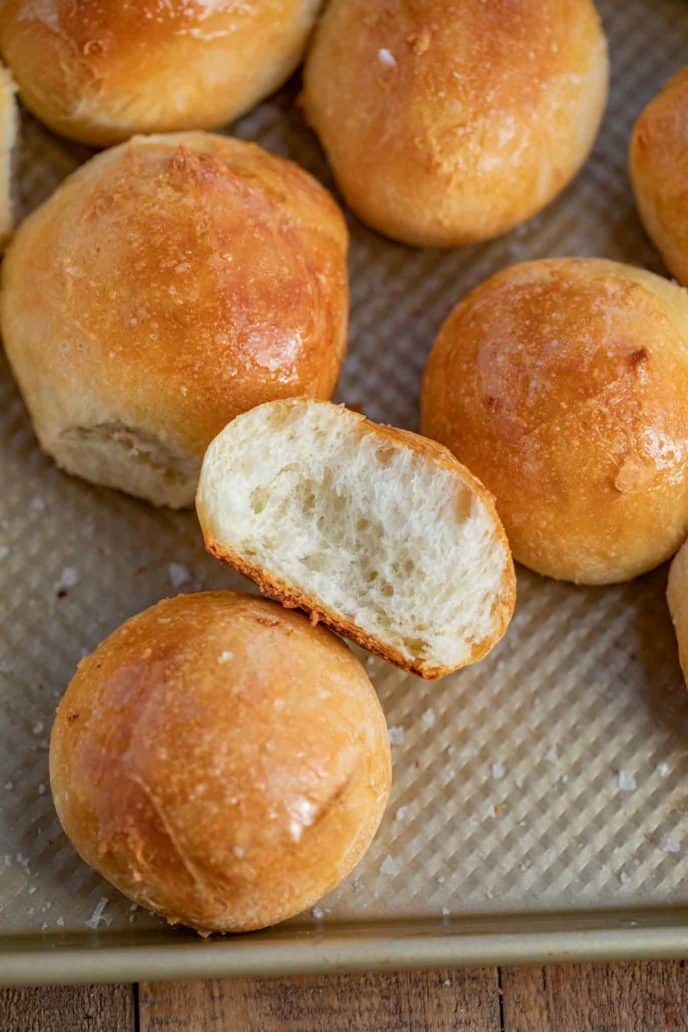 FRENCH BREAD ROLLS
FRENCH BREAD ROLLS
French Bread Rolls are the PERFECT thing to serve with dinner. They’re soft and fluffy on the inside, and crusty on the outside like a French baguette. This is one of my go-to roll recipes because they’re also an incredibly easy yeast bread to make, plus you don’t have to knead it by hand because it’s done entirely in the stand mixer!
I love to serve this french bread recipe for lunch with Classic Minestrone Soup or a Classic Wedge Salad, or for dinner with my Meat Lasagna. This roll recipe also works perfectly with my Sloppy Joe fillings. If you want a more flaky breakfast option you can also check out my recipe for Buttermilk Biscuits!
HOW LONG DO FRENCH BREAD ROLLS LAST?
French bread dinner rolls will last at room temperature for 4-5 days, wrapped tightly. You can also store them in an airtight container to keep them soft. Heat the french bread in the oven wrapped in tinfoil at 200 degrees F to make them seem fresh-baked again before serving.
CAN YOU FREEZE FRENCH BREAD DINNER ROLLS?
French bread rolls can be frozen either before or after they’ve been cooked. For cooked, freeze them in a sealable plastic bag wrapped in tinfoil. Defrost at room temperature for a few hours before serving, or reheat in the oven to make them soft and crusty again.
For uncooked, divide the dough into balls, then place on a baking sheet and place in the freezer. Once they’re frozen, about an hour, you can move them to a plastic bag. When you’re ready to bake, place them back on the baking sheet and bake according to the recipe, spraying with cold water to make them extra crusty (make sure it’s cold, warm water won’t work as well).
WHY IS MY FRENCH BREAD SO HARD?
If your roll recipe turns out too hard, it’s possible that you’re overcooking the rolls. Set a timer, and use an oven thermometer to make sure the oven is cooking at the right temperature.
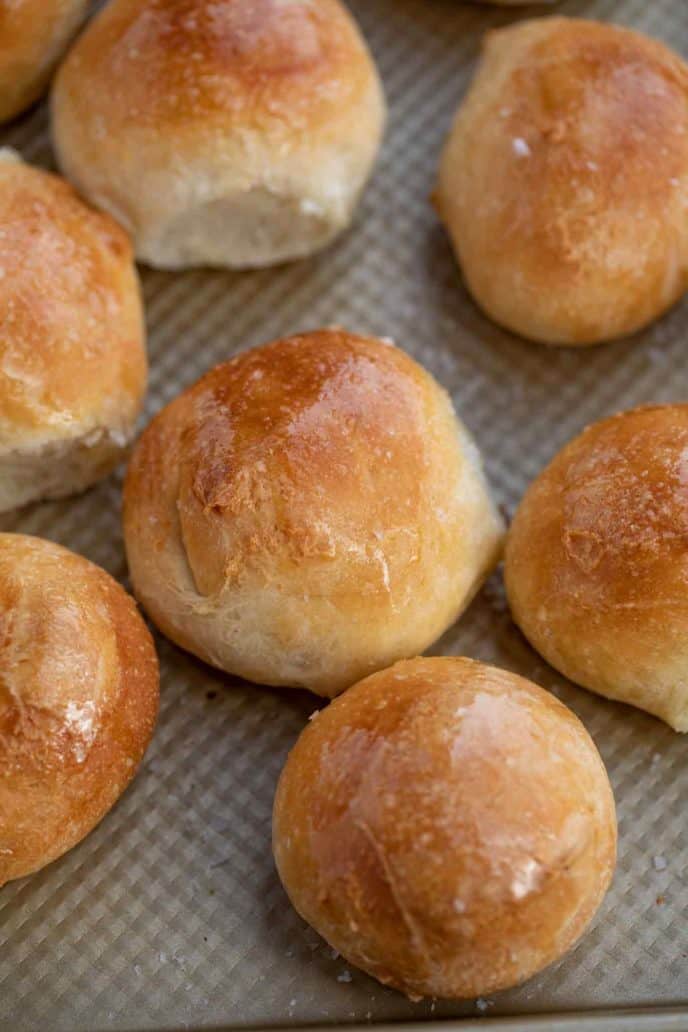
Create a free account to Save Recipes
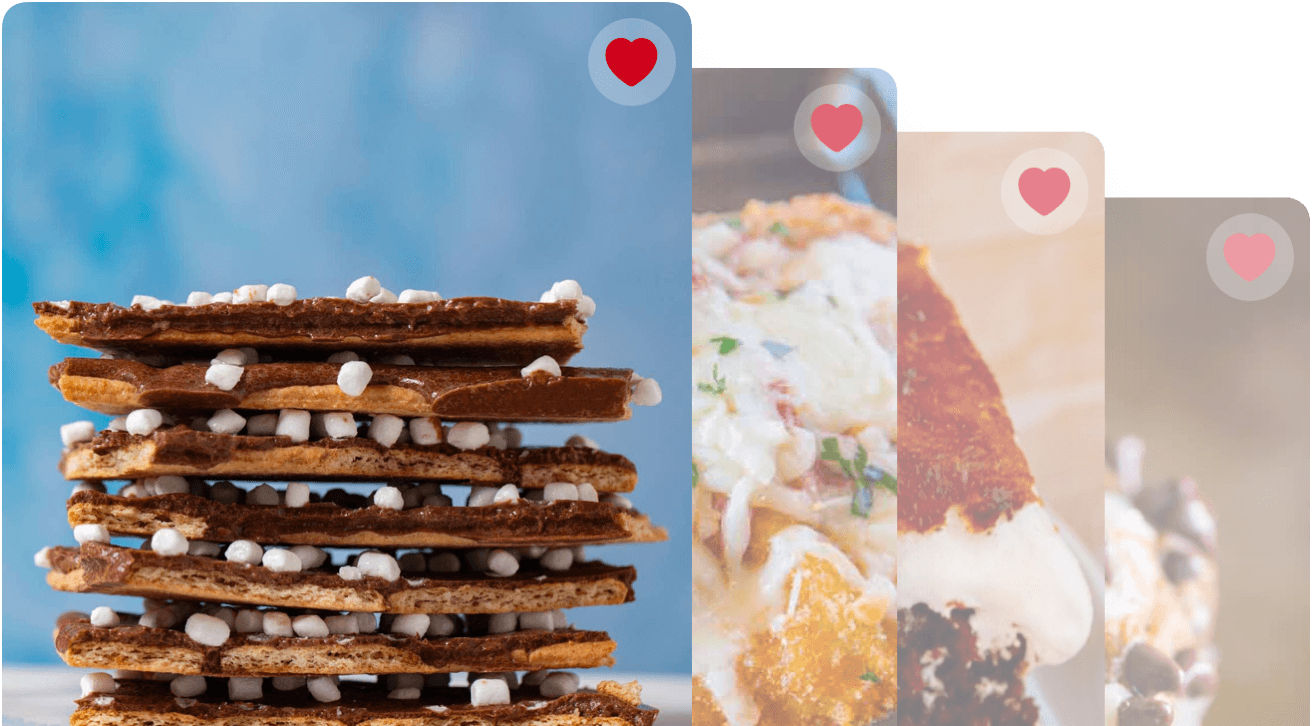
WHICH FLOUR DO YOU USE FOR FRENCH BREAD?
Some french bread recipes call for bread flour, because bread flour contains more protein. But I find that all purpose flour works fine instead of bread flour for this french bread recipe. You can also use whole wheat or other wheat flour for a healthier version.
SOUPS TO ENJOY WITH THESE ROLLS
- Cabbage Soup
- Vegetable Soup
- Classic Chicken Noodle Soup
- Easy Taco Soup
- Ultimate Slow Cooker Beef Stew
TIPS FOR MAKING FRENCH BREAD ROLLS
- Make sure to set a timer and let the yeast and sugar sit in the hot water for the full time in this bread recipe. This step is called “proofing”, and it lets the yeast activate. The water will look cloudy and slightly foamy when it’s ready to use. I let it proof in the stand mixer, but you can use any large bowl.
- When you’re letting the dough rise, the yeast needs a warm environment to grow. I usually put it near a window, or if your oven is on for another recipe you can keep it on top of the stove.
- Make sure your yeast is as fresh as possible for this bread recipe. If the packet is expired, I recommend not using it, because your french bread won’t rise correctly.
- Watch the french bread dough carefully, and stop kneading when it starts pulling away from the bowl. Kneading the dough for too long can result in dense rolls.
- We’re using the stand mixer for this bread recipe, but you can knead it by hand if you want to.
- You can use this same french bread recipe to make french bread dinner rolls or an actual loaf or baguette. Or roll them very thin and make breadsticks! You can also buy a baguette pan that will help keep the baguettes crispy on the top and bottom.
- Wrap these french bread dinner rolls in tinfoil after they’re done baking, to keep them warm until you’re ready to serve.
- Line your baking sheet with parchment paper to help keep the french bread from sticking.
- You can substitute the active dry yeast with rapid rise yeast if you have to.
- If the dough is sticking to your hands while you’re trying to work with it, dust your hands with flour lightly.
- Brush the baguette dough with egg wash, or with butter to make the outside golden brown. You can also use a sharp knife to slice down the middle top of the roll for presentation.
- Serve this french bread with soft butter or olive oil and herbs, and a sprinkle of flaky sea salt (my favorite fancy yet inexpensive finishing touch on foods) on top.
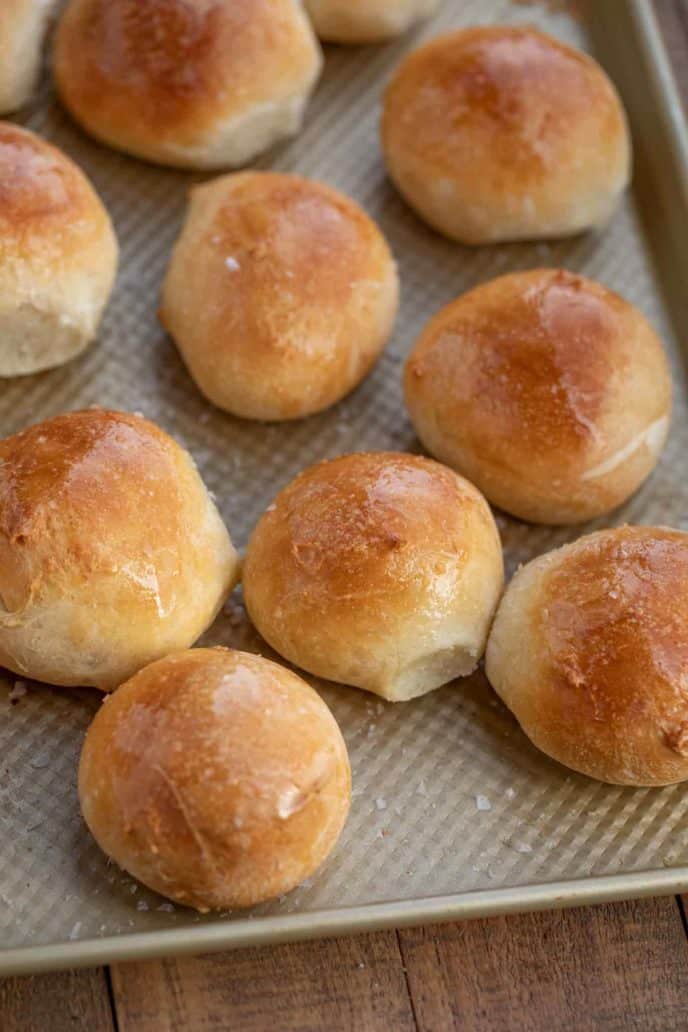


Ingredients
- 1 1/2 cups warm water (110 degrees)
- 3 teaspoons active dry yeast
- 2 tablespoons sugar
- 2 tablespoons vegetable oil
- 2 teaspoons kosher salt , divided
- 3 1/2 cups flour
- 2 tablespoons unsalted butter , melted
- spray bottle with ice water
Instructions
- To a stand mixer add the warm water, yeast and sugar and let sit for 10 minutes until cloudy.
- Add the oil, half the salt and 2 cups of the flour with the dough hook and let it combine on medium speed adding the flour in ¼ cup increments until the dough starts to come together and eventually starts to pull away from the bowl, then turn up the speed and let it knead for 5 minutes.
- Add to an oiled bowl and turn in the bowl to coat with oil then cover with a damp towel and let rise in a warm spot until it doubles in size for 60 minutes.
- Divide the dough into 16 balls, place on a greased baking sheet and let rise for an additional 30 minutes then brush gently with butter and sprinkle with remaining salt before baking at 400 degrees for 18-20 minutes spraying the dough with ice water twice halfway through the baking process to make the crust chewier.
Nutrition
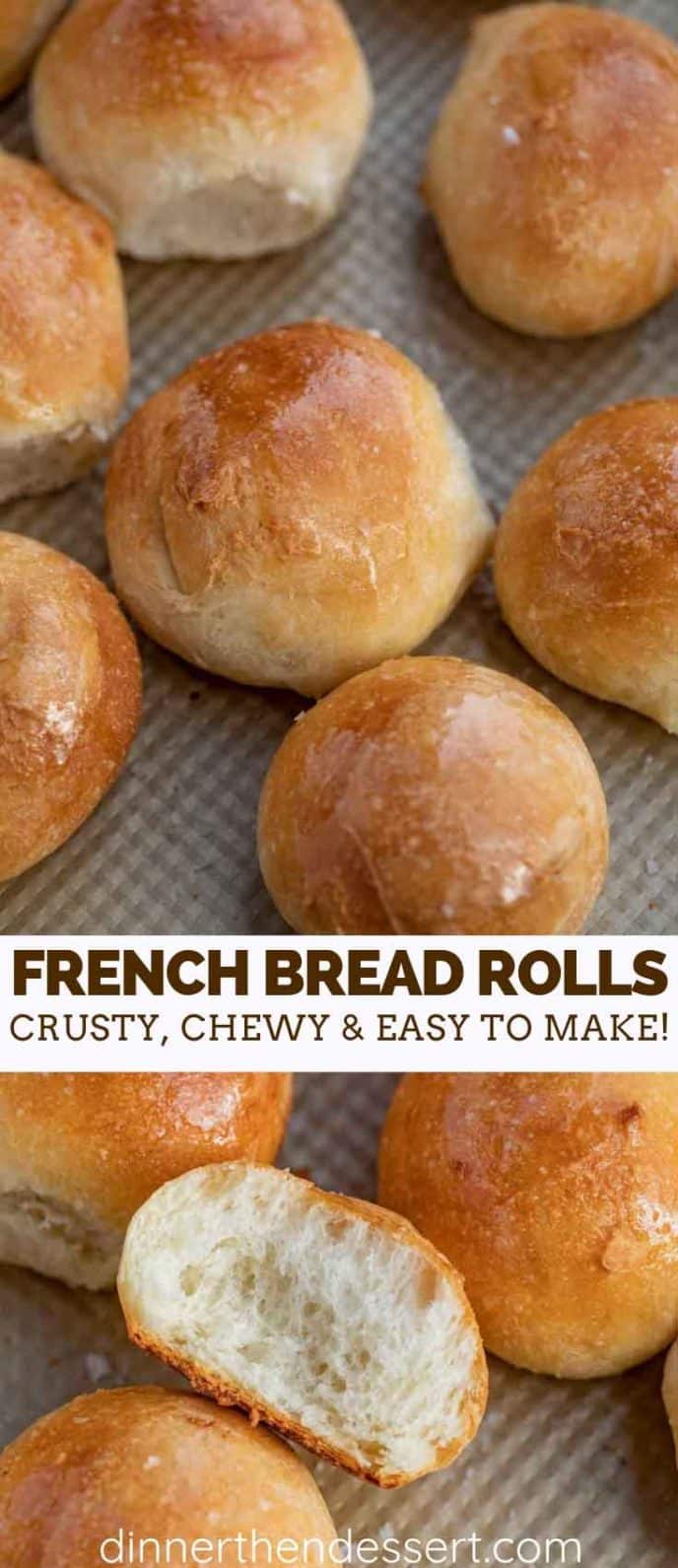
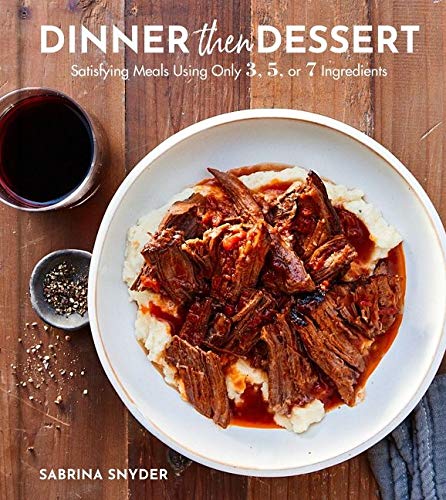
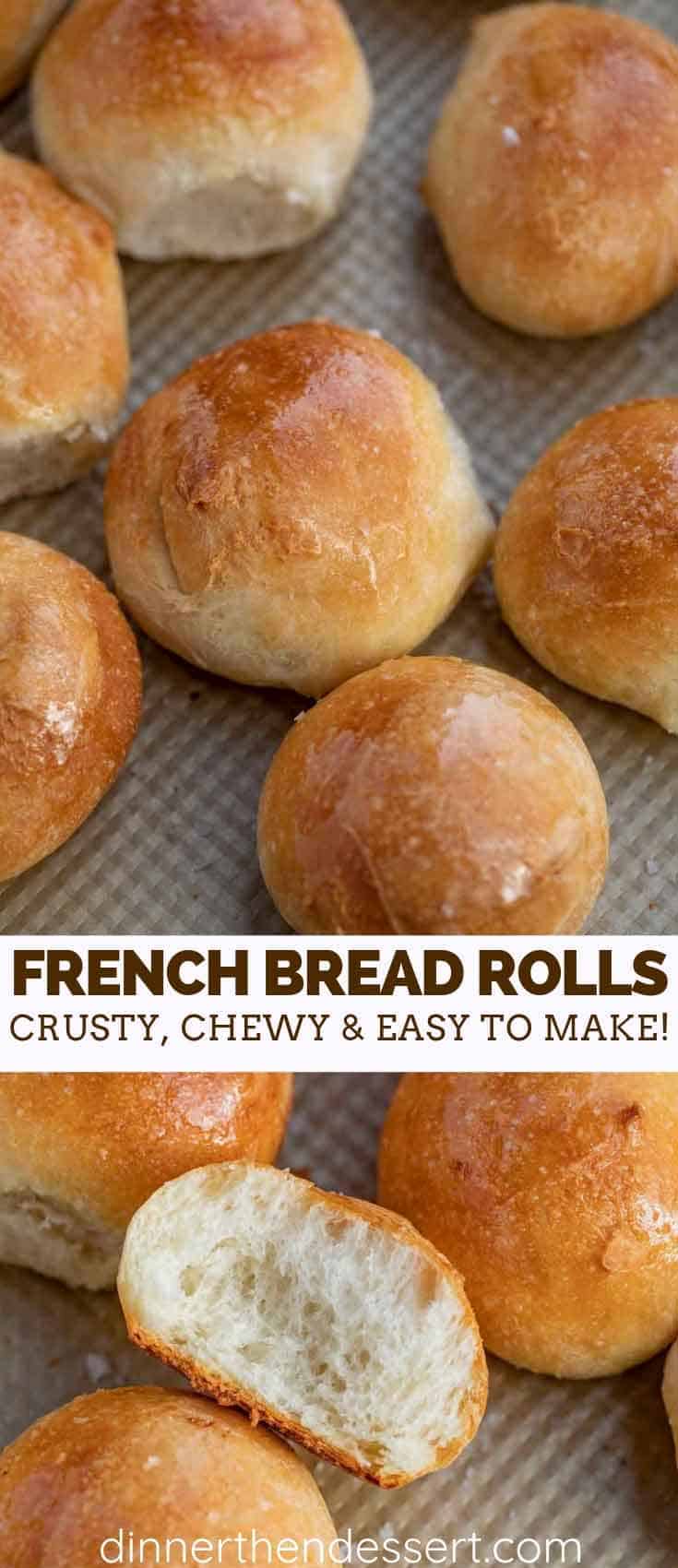
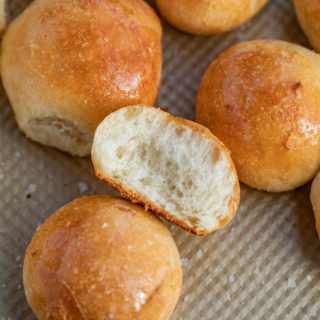

An absolutely fantastic recipe and I will be making this often in the future. Planning to make some for the freezer next weekend so that my husband can just pop a couple into the oven when he wants fresh buns.
Thank you Stephanie. Great idea to freeze the rolls and thanks so much for the 5 star review!
The rolls turned out great and were delicious! I did freeze half the batch to bake later.
Made for first time for Easter dinner tomorrow. Had two extra and these are the best. This receipt does not disappoint! My husband said I can make them every week…personally, I could eat the whole batch warm and with butter. Thank you for sharing.
So good!! Can I use bread flour too?
Yes! Thank you for the 5 star review Tara.
Beautiful perfect crusty buns so glad I followed this recipe best I have ever made thankyou
Hi, I wish I could take all my previous 5 star ratings and put them on this one! I’ve made rolls, hoagies and just now a boule and it came our great. The recipe is so simple and easy, i can remember it without looking it up. It’s my new go-to for bread. Thanks for such a great recipe! Question, please-is the goal of other bread recipes to use as little yeast as possible to allow for time to do the heavy lifting to develop yeast and since this one is so fast, you have to use more yeast for the heavy lifting (1 T=3tsp), which is significantly more? TIA
I have a question can I use almond flour on these rolls? Thank you. Or gluten-free flour
I haven’t tested this recipe with gluten-free flour. If you try it, please let us know how it turns out.
Wow! These rolls were so easy to make! I toooed them with Icelandic lava salt to make them look super fancy and impressive! I’m glad to find out that they can be frozen as there are jus two of us in the house. I can pull out what I need on soup nights. Thanks for a great recipe.
You’re welcome! Thanks so much for the 5 star review Julie 🙂
Delicious and easy recipe, made three times already! It does not last in my house! I just need to double the recipe. Thank you for sharing!
Really appreciate your feedback and 5 star review Suzette! Thank you!
One of the best breads we’ve baked.
I am freezing some of the dough. When ready to bake, does the dough go straight from freezer to oven or does it need to defrost and rise?
Defrost and rise! Thank you for asking.
Second time making these french bread rolls, they come out so yummy.
I’ve made these several times and they are easy and delicious. After baking them i keep them frozen in a vacuum bag and warm them in my air fryer. Always have fresh bread available.
Easy. And delicious ?
This is a wonderful crusty bread ? ?Thank you for sharing ? I wish I can share my beautiful crusty bread picture lol. Happy New Year!
I just made these, so delicious! I was tired of making French bread so thought I’d try buns instead. I omitted 1 tbsp sugar and used 2 cups white flour and 1.5 cups whole wheat flour. I made 15, to fit my cookie sheet. Turned out perfect. Mine where done baking at 18 min, one already eaten at 20 minutes, lol.
I haven’t baked these yet, but I’m tempted not to at all bc I had a lot of trouble with this dough. I was making by hand and measured ingredients. When it was time to knead the dough was extremely sticky. Even covering my hands and surface with flour did not help. I must have added a cup of flour before I could really knead. I’m sure this is too much and they won’t turn out right. Maybe I will make bread sticks like you suggest. Any idea what I’m doing wrong? Maybe the recipe needs a blender.
That sounds frustrating. I am not sure why you had to use a cup of flour in order to knead the rolls. Did the dough ever pull away from the edge of the bowl while rising? Let us know what you decided to do and how they turned out.
Could i do the prep for these in my bread machine? I don’t have a hook for my mixer and I hate to knead by hand. I don’t usually proof my yeast prior to using my bread machine would I need to proof my yeast first like your instructions and then add the rest to machine like you do for the mixer or does it really make a difference since I would be using a bread machine?
Great questions Trina! I’m guessing that proofing the yeast first would be best. Having never used a bread machine with this recipe, I’m not sure how the dough will turn out. I do know that if you over knead the dough the rolls will be too dense. Let us know how they turned out. I would be interested in your feedback!
Sabrina, Please point me in the right direction. What is the main diff between these rolls and your easy dinner rolls. I want to make one for a bread basket for Christmas dinner with a roast beef tenderloin meal. What would be your preference here? Thank you.
PS if one does better in advance or freeze and reheat that would help
Followed this recipe exactly as indicated and OMG… best rolls I have ever made ? thank you!
Thanks Alex. And thanks for the 5 star review.
I made this recipe and my husband loved them and said do not change a thing! However, when making this recipe when the dough started to pull away from the bowl it seemed too wet and sticky to me (in anticipation of the rolls and the end product picture), so I added what amounted to 4 1/4 cups of flour! Is the dough suppose to be sticky and wet?
Also, usually when making bread I add the bottom of a broiler pan to the bottom of the stove when preheating. When adding the bread to the oven I throw ice cubes into the pan. What do you think of this method for this recipe?
Wow, that’s a lot of additional flour! And your broiler pan technique isn’t something I’m familiar with. I’m sorry you encountered these challenges but I’m happy to hear the end product was tasty.
I don’t have a stand mixer, how will I know it’s time to stop when hand kneading?
Here’s some tips
Watch the french bread dough carefully, and stop kneading when it starts pulling away from the bowl. Kneading the dough for too long can result in dense rolls.
We’re using the stand mixer for this bread recipe, but you can knead it by hand if you want to.
Can you prepare the dough and the refrigerate it for a day? I want to make larger rolls for turkey sandwhichs
French bread rolls can be frozen either before or after they’ve been cooked. For cooked, freeze them in a sealable plastic bag wrapped in tinfoil. Defrost at room temperature for a few hours before serving, or reheat in the oven to make them soft and crusty again.
Can the dough prove over night or would it be better to bake them in advance and reheat?
Bake in advance and reheat. Thanks for asking!
I have bread yeast and the instant yeast, can I use either of these?
You may use either yeast.
Finding it hard to get active dry yeast, can I use easy bake instead and how much should I use for this recipe.
Oh oh. I haven’t tested this recipe with easy bake? Have you tried ordering your active dry yeast online yet?
Can I use salted butter?l
Yes you can; however, I recommend that you cut back on the amount of salt that the recipe calls for a bit.
Easy to make, excellent recipe. It will be my go to from now on. ?
Easy and very tasty rolls. I halfed the recipe and they turned out excellent. Beautiful dough to work with. Will definitely be making these again. Thank you for the recipe.
Made them twice now and they turned out delicious.
Two quick questions before I attempt this, what appears to be, a simple and relatively quick recipe for these rolls. (1) can I use instant yeast instead (adjusted accordingly), and (2) are you using All Purpose or Bread flour? Thanks.
1) yes
2) All Purpose
I apologize for the delayed response to your questions. My guess is you probably have already made the recipe? How did they turn out?
These were delicious. Putting on the melted butter caused them to deflate and end up flatter than the pics on here. Not sure how to fix that. Maybe pzt. butter on before the 30 minute rise?
Oh no, that’s disappointing. I haven’t experienced rolls deflating because I added melted butter on them. Typically, my rolls deflate if I added too much water to the dough or I had a bad batch of yeast. Sometimes it’s is because I over-proofed the bread dough or didn’t knead the dough enough.
These are incredible . Easy to make I was surprised pleasantly of course afraid my family won’t believe I made them from scratch they are so good
Thanks Julie! So glad your enjoyed the French Bread Rolls and thanks for the 5 star rating!
Experimented with these today by making half a recipe. They were very good! The dough seemed very soft and they did not turn out not as round as shown but flatter. Not sure if a whole recipe would have made a difference. Definitely going to make these again.
Wonderful rolls! I started with making two batches for a trip. Some ended up eaten because hungry boys couldn’t resist the smell. Before the night was through, a third batch happened. These are super easy and delicious! Highly recommended ??
So easy and delicious!
Sabrina has the best recipes. You will know what she writes is exactly on point. You will never fail.
To proof my dough for anything, I find putting it in the oven with just the light on works well every time.
Just made theses buns today first try! They turned out Awsome! Thank you for such an easy and Well Turnerned Out Recipie !
I want to try your recipe; the rolls look so good. I wanted to make about 60 of them for an upcoming party next week. But I need to know how many grams of flour you consider to be a cup. Everyone’s cups are different.
BTW, measuring flour in cups is a recipe for disaster because they’re wildly inaccurate (packed vs sifted, level vs heaping, etc not to mention cups aren’t calibrated) The general guideline is 120g = 1 cup for regular AP flour. How did you measure yours?
Measure the yeast and flour exactly, using a butter knife to level off the measuring spoon or cup. Too much yeast or flour in a bread recipe makes it dry and crumbly.
Yes, I agree. Too much flour ruins the recipe. So just to be clear (because you didn’t really answer the question), you measured each cup by simply putting flour into your 1 cup measuring cup and leveled it off w/ a butter knife? Please let me know. If so, and that works for you, that’s awesome but it won’t work for a good percentage of us because using cups is nowhere near exact (do a little research) ONLY because it’s not repeatable one person to the next. Your rolls look so good, but if all you have is cups I don’t want to waste half a day making rolls that have 15-20% more or less flour than you used. I would have just moved on to a recipe from someone who uses grams (1:1) but yours look so perfect.
I was just told from my wife that my words sounded rude. If you took it that way, please accept my apology because I didn’t mean for it to sound that way. I just want to know if you have a kitchen scale w/ grams, how many grams do/did you consider a cup to be?
If you’re going to take the time to offer recipes for us to follow, just know we can’t follow something that’s inherently “off”. Unfortunately, bread making is more exact than people like it to be.
Perhaps this will help. Our recipe card has an option to review the recipe using Metric measurements. Click on Metric at the top of the recipe card and then all of the ingredients convert to metric measurements. 120 grams is one cup and weights 4.5 ounces. Hope that helps.
Yes, that’s helpful. Thank you for taking time to answer. Trying your rolls now…
The quick view at the recipe says 30 minutes prep and 30 minutes to cook. So I was pretty upset to find out an hour before I wanted them to be ready that they should rise for an hour!
I understand I should have read the recipe sooner but it would be a big help if the time estimates could be fixed to include that rise time!!
Hi Michelle, Thank you for your feedback. Duly noted!
Click on the metric option in the recipe. Pretty simple answer to your question/concern.
Need to try
I don’t understand what I am doing wrong….can’t get the dough to rise….help!
Make sure to set a timer and let the yeast and sugar sit in the hot water for the full time in this bread recipe. This step is called “proofing”, and it lets the yeast activate. The water will look cloudy and slightly foamy when it’s ready to use. I let it proof in the stand mixer, but you can use any large bowl.
When you’re letting the dough rise, the yeast needs a warm environment to grow. I usually put it near a window, or if your oven is on for another recipe you can keep it on top of the stove.
Make sure your yeast is as fresh as possible for this bread recipe. If the packet is expired, I recommend not using it, because your french bread won’t rise correctly.
This my new go to for lunch buns!
So easy .. and delicious
FIrst time out, I followed the recipe…………….THAT good. My cooking usually isn’t GOOD good.
I froze half and they were just as good a few days later. Pure Magic.
We loved this recipe. I made half a recipe since it is only my husband and I. The bread is tender and fluffy with a nice crust the little topping of salt on top hit it out of the ballpark. I will keep this one in my recipe box.
I made 9 big buns for hamburgers…….they turned out AMAZING !!!!
My Boys loved them. I will be making these very often.
Thanks for a fabulous recipe !!!
My family loved these. I will definitely make them again. They were pretty flat, though, not like in the pictures. We cut them in have to use as sandwich rolls.
I made these today. They taste exactly like the crusty rolls in English bakeries. Thank you so much for sharing. Direction were perfect. I’ll be making these all the time.